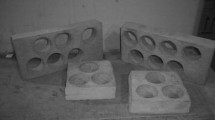Abstract
This paper deals with an experimental investigation on the strength of stone and stone masonry. Granitoidgneiss is commonly used for masonry construction in India. The compressive strength of stone has been determined through 80 mm size cubes. It has been found that the compressive strength of granitoid-gneiss is greater when the load is parallel to the mineral bands. The compressive strength of stone masonry was studied through masonry prisms using 1∶4 and 1∶8 cement mortars. These tests have revealed that masonry strength is higher when the load applied is parallel to the mineral bands. The flexural bond strength of stone masonry walls was studied through full-scale tests. Flexural bond strength appears to play a major role in the failure of stone masonry walls.
Résumé
On présente une étude expérimentale de la résistance de la pierre et des maçonneries de pierre. En Inde, les pierres les plus souvent utilisées en maçonnerie sont des gneiss granitoïdes. La résistance à la compression de la pierre a été déterminée sur des cubes de 80 mm. Les résultats montrent que la résistance à la compression du gneiss granitoïde s'augmente lorsque la charge est parallèle aux bandes minérales. La résistance à la compression de ces maçonneries a été étudiée à partir d'éléments prismatiques utilisant des mortiers de ciment de 1∶4 et de 1∶8. Ces essais ont montré que la résistance de la maçonnerie est supérieure lorsque la charge est parallèle aux bandes minérales. Des essais complets ont été effectués sur la résistance de l'adhérence en flexion des murs en maçonnerie de pierre. La résistance de l'adhérence en flexion semble jouer un rôle important dans la détérioration des murs en maçonnerie de pierre.
Similar content being viewed by others
References
IS:1121, ‘Indian Standard Code of Practice for Method of Test for Determination of Strength Properties of Natural Building Stones: Part 1: Compressive Strength’ (Bureau of Indian Standards, 1976).
Mohamedbhai, G.T.G., Chan Chin Yuk, C.W. and Baguant, B.K., ‘Use of stone masonry in housing construction in Rodrigues’, Proceedings of 3rd International Seminar on Structural Masonry for Developing Countries (Mauritius, 1990) 17–22.
ASTM E447, ‘Standard Test for Compressive Strength of Masonry Prisms’ (American Standards for Testing and Materials, 1984).
IS: 1905, ‘Indian Standard Code of Practice for Structural Use of Unreinforced Masonry’ (Bureau of Indian Standards, 1987).
‘National Building Code of India’ (Bureau of Indian Standards, 1970).
Venu Madhava Rao, K., ‘Some studies on flexural and compressive strength of masonry’, M. Sc. (Engg.) Thesis, Dept. of Civil Engineering, Indian Institute of Science, Bangalore, India, 1993.
Venkatarama Reddy, B.V., ‘Studies on static soil compaction and compacted soil-cement blocks for walls’, Ph. D. Thesis, Dept. of Civil Engineering, Indian Institute of Science, Bangalore, India, 1991.
Hendry, A.W., ‘Structural Masonry’ (MacMillan Education Ltd., London, 1990).
Shrinivas Rao, S., ‘Studies on soil-cement blocks and block masonry’, M. Sc. (Engg.) Thesis, Dept. of Civil Engineering, Indian Institute of Science, Bangalore, India, 1993.
Author information
Authors and Affiliations
Rights and permissions
About this article
Cite this article
Venu Madhava Rao, K., Venkatarama Reddy, B.V. & Jagadish, K.S. Strength characteristics of stone masonry. Mat. Struct. 30, 233–237 (1997). https://doi.org/10.1007/BF02486181
Issue Date:
DOI: https://doi.org/10.1007/BF02486181




